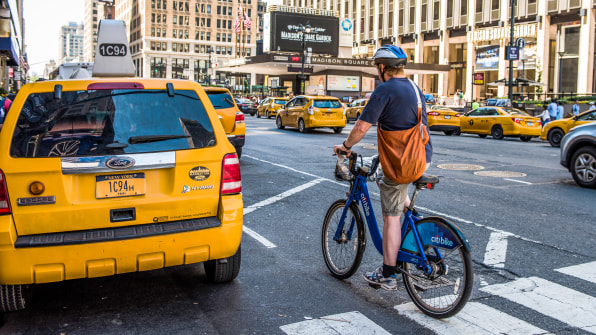In New York, you'll now get there faster on a bike than in a cab
)
If the lack of emissions or bonus exercise isn’t reason enough to ride a bike instead of a car to work in New York City, here’s another perk. According to this year’s Mobility Report, released by the city’s Department of Transportation, riding a bicycle may get you to your destination a lot faster than taking a cab.
The report found that taxi speeds in Manhattan’s central business district (an area extending from the city’s southern tip up to the base of Central Park) have been steadily decreasing over the past five years. In 2013, the average taxi speed was 8.5 miles per hour. By 2018 (the city’s most recent numbers), it had gone to 7 miles per hour. This gets even slower if you look specifically at the “Midtown core,” an area bounded by the East River, Ninth Avenue, 59th Street, and 35th Street, and populated largely by office towers. There, cab trips slowed to 4.9 miles per hour in 2018.
On the flipside, Citi Bikes are proliferating, and tend to arrive at their Manhattan destinations faster than cabs. A trip of up to half a mile in the city takes, on average, five minutes and 37 seconds by cab but just four minutes on a Citi Bike. That makes riding a bike about 30% faster. The same goes for longer rides. A trip between 1.5 and 2 miles in Midtown takes just more than 21 minutes in a taxi and 14 minutes, 30 seconds on a Citi Bike.
Using a Citi Bike not only produces zero carbon emissions, but it’s also a lot cheaper than hailing a taxi. That 14.5-minute trip in Midtown costs $1.87 on a Citi Bike—while you’d have to pay $13.60 to sit for an extra 6.5 minutes in a cab.
 [Photo: ablokhin/iStock]
[Photo: ablokhin/iStock]
Taxis accounted for many more trips in the DOT’s report than Citi Bikes, however. The report looked at 12,252 taxi trips and only 2,850 Citi Bike rides to get the above numbers. But while automobile traffic is increasing in New York City, especially with the proliferation of Uber, Lyft, and other ride-hailing ventures, so is the number of Citi Bikes. In October 2015, about 1,673 Citi Bike trips took place in Midtown per day, while 2,578 did in the same area in October three years later.
The growing car traffic has its consequences. Public buses are slowing down as more and more “for-hire vehicles” (Lyfts and Ubers as well as taxis and other car services) are populating city roads. The number of for-hire cars more than doubled between 2011 and 2017, going from 44,400 to 100,700. In that time period, the population in New York City (including the outer boroughs) increased from 8.28 million to 8.62 million. Tourism went up, as well.
“Our roadways are more congested than ever,” writes DOT Commissioner Polly Trottenberg in the Mobility Report, adding that expanding the Citi Bike program aims to help with this issue. By 2023, Citi Bikes will be available in several new neighborhoods in the Bronx, Brooklyn, Manhattan, and Queens. The additions will make Citi Bikes available throughout all Manhattan neighborhoods. Unfortunately, it’s not easy being a cyclist in a city with so many motor vehicles. Eight people have died while riding their bikes in the city this summer, bringing the total of New York City bike deaths in 2019 up to 19.
The DOT is trying to curb city biking deaths and injuries by making “better and expanded bicycle infrastructure around the city,” writes Trottenberg. Over the last five years, for example, the DOT added more than 82 miles of protected bicycle lanes. And with all that, the number of cyclists is going up. A DOT report dedicated to city bicycling from May 2019 found that the number of adults who biked “at least several times a month” went from 632,000 in 2012, the year before Citi Bikes launched, to about 793,000 in 2017.
Source: Fast Company
New York Build is the leading construction show for New York and the Tri-state region. Gain access to 9 specialized summits, 200+ exhibitors, 200+ speakers and connect with 17,000+ registered visitors.


)